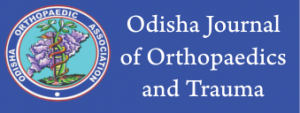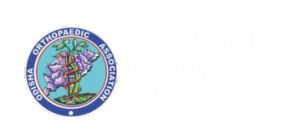Open fractures of Tibia treated by unreamed interlocking nailing
Vol 01| January 2020 | page: 3-6 | Nirmal Chandra Mohapatra, Udit Saurav Sahoo
DOI- 10.13107/ojot.2020.v41i01.003
Authors: Nirmal Chandra Mohapatra [1], Udit Saurav Sahoo [1]
[1] Department of Orthopaedics, SCB Medical College, Cuttack, Odisha, India.
Address of Correspondence
Dr. Udit Sourav Sahoo
SCB Medical College, Cuttack, Odisha, India.
E-mail: uditsouravsahoo@gmail.com
Abstract
Objective: To assess the clinical outcome of unreamed intramedullary interlocking nailing in open fractures of tibia, and to evaluate the incidence of complications in these open fractures as a result of the same.
Methods: Between June 2018 and May 2019, a total of 56 cases of open tibial shaft fractures were operated on with unreamed interlocking nails at SCB MCH, Cuttack, India. Records of 52 patients (18 women and 34 men) were available for study. Only injuries associated with the tibial shaft were included. Traffic accidents were the cause of fractures. All fractures were classified according to Gustilo and Anderson classification for open fractures. There were 28(53.8%) type-I, 16 (30.7%) type-II, 8 (15.3%) type- IIIA fractures. After thorough debridement under anaesthesia, an unreamed interlocking nail was inserted. All nails were locked proximally and distally.
Results: The patients were followed up for a mean period of 19 months (range, 18–24 months) and were evaluated according to the modified Ketenjian’s criteria. Results were good to excellent in 85.8% cases, and poor in 10.7% cases. Only 2 of 8 patients with type-III fractures had good results. Of 56 patients, 6 had superficial infection, 4 had deep infection, 6 had delayed union, 1 had infected non-union, 3 had malunion, 6 had screw breakage, and 10 had anterior knee pain.
Conclusion: Unreamed interlocking tibial nailing can be safely used for type-I and type-II open injuries even with delayed presentation. Use of unreamed nailing in type-III fractures with delayed presentation has high incidence of complications in this study.
Keywords: Unreamed interlocking nail, Open tibial fractures.
References
1. Bach AW, Hansen Jr ST (1989) Plates versus external fixation in severe open tibial shaft fractures: a randomized trial. Clin Orthop 241:89–94
2. Bonatus T, Olson SA, Lee S, Chapman MW (1997) Non- reamed locking intramedullary nailing for open fractures of the tibia. Clin Orthop 339:58–64
3. Court-Brown CM, McQueen MM, Quaba AA, Christie J (1991) Locked intramedullary nailing of open tibial fractures. J Bone Joint Surg Br 73:959–964
4. Gustilo RB, Anderson JT (1976) Prevention of infection in the treatment of one-thousand and twenty-five open fractures of long bones: retrospective and prospective analyses. J Bone Joint Surg Am 58:453–458
5. Hasenhuttl K (1981) The treatment of unstable fractures of the tibia and fibula with flexible medullary wires. A review of two-hundred and thirty-five fractures. J Bone Joint Surg Am 63:921–931
6. Henley MB, Chapman JR, Agel J, Harvey J, Whorton AM, Swiontkowski MF (1998) Treatment of type II, IIIA, and IIIB open fractures of tibial shaft. A prospective comparison of un- reamed interlocking intramedullary nails and half-pin external fixators. J Orthop Trauma 12:1–7
7. Holbrook JL, Swiontkowski MF, Sanders R (1989) Treatment of open fractures of the tibial shaft: ender nailing versus exter- nal fixation. A randomized prospective comparison. J Bone Joint Surg Am 71:1231–1238
8. Klein MP, Rahn BA, Frigg R, Kessler S, Perren SM (1989) Reaming versus non-reaming in medullary nailing: inter- ference with cortical circulation of the canine tibia. Arch Orthop Trauma Surg 109:314–316
9. Klemm KW, Borner M (1986) Interlocking nailing of complex fractures of the femur and tibia. Clin Orthop 212:89–100
10. Lottes JO (1974) Medullary nailing of the tibia with triflange nail. Clin Orthop 105:53–66
11. Melcher GA, Metzdorf A, Schegel U, Ziegler WJ, Perren SM, Printzen G (1995) Influence of reaming versus nonreaming in intramedullary nailing on local infection rate: experimental investigation in rabbits. J Trauma 39:1123–1128
12. Schandelmaier P, Krettek C, Rudolf J, Kohl A, Katz BE, Tscherne H (1997) Superior results of tibial rodding versus ex- ternal fixation in grade 3B fractures. Clin Orthop 342:164–172
13. Stegemann P, Lorio M, Soriano R, Bone L (1995) Manage- ment protocol for unreamed interlocking tibial nails for open tibial fractures. J Orthop Trauma 9:117–120
14. Tornetta P 3rd, Bergman M, Watnik N, Berlowitz G, Steuer J (1994) Treatment of grade-IIIb open tibial fractures. A pro- spective randomised comparison of external fixation and non- reamed locked nailing. J Bone Joint Surg Br 76:13–19
15. Whittle AP, Russel TA, Taylor JC, Lavelle DG (1992) Treatment of open fractures of the tibial shaft with the use of interlocking nailing without reaming. J Bone Joint Surg Am 74:1162–1171
16. KneifelT, Buckley R. A comparison of one versus two distal locking screws in tibial fractures treated with unreamed tibial nails: a prospective randomized clinical trial. Injury 1996;27:271–3.
| How to Cite this Article: Mohapatra N, Sahoo U S. | Open fractures of tibia treated by unreamed interlocking nailing. | Odisha Journal of Orthopaedics and Trauma | January 2020; 01: 3-6 . https://doi.org/10.13107/ojot.2020.v41i01.003 |
(Abstract Text HTML) (Download PDF)
.


